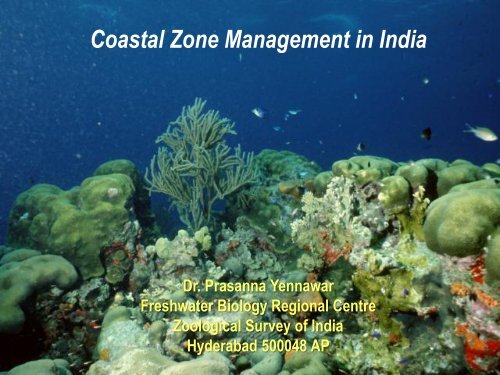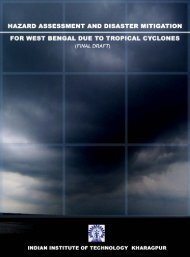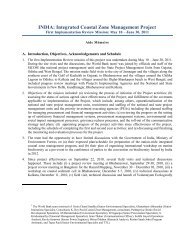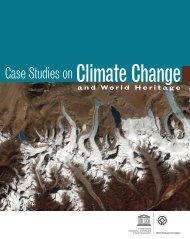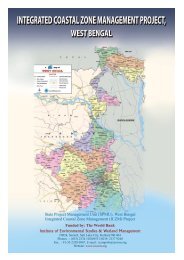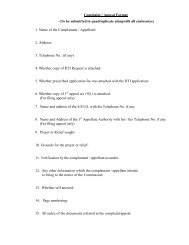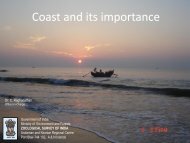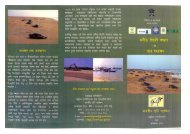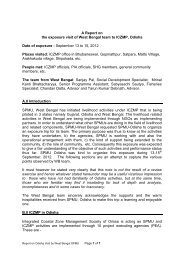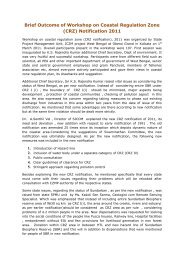Coastal Zone Management in India - Iczmpwb.org
Coastal Zone Management in India - Iczmpwb.org
Coastal Zone Management in India - Iczmpwb.org
You also want an ePaper? Increase the reach of your titles
YUMPU automatically turns print PDFs into web optimized ePapers that Google loves.
<strong>Coastal</strong> <strong>Zone</strong> <strong>Management</strong> <strong>in</strong> <strong>India</strong><br />
Dr. Prasanna Yennawar<br />
Freshwater Biology Regional Centre<br />
Zoological Survey of <strong>India</strong><br />
Hyderabad 500048 AP
PREAMBLE<br />
‣ <strong>India</strong> is one of the 12 mega-biodiversity centres <strong>in</strong> the world.<br />
‣ <strong>India</strong> – 4 th largest producer of farmed shrimp <strong>in</strong><br />
the eastern hemisphere.<br />
‣ Fishes: About 12% of all the world’s fishes are <strong>in</strong> <strong>India</strong>, or<br />
about 2200 species.<br />
‣ Wetlands: About 4 million ha (2.6 million are man-made).<br />
‣ Significant erosion of <strong>India</strong>’s biodiversity at the ecosystem,<br />
species and genetic level has already taken place.
Root casuses of loss of biodiversity<br />
Qualitative <strong>in</strong> nature.<br />
Major causes of loss of biodiversity <strong>in</strong>clude:<br />
habitat destruction and degradation,<br />
over-exploitation of liv<strong>in</strong>g resources,<br />
<strong>in</strong>troduction of exotics,<br />
human <strong>in</strong>duced changes, and<br />
climate change<br />
<strong>in</strong>creas<strong>in</strong>g social, political and economic <strong>in</strong>equities;<br />
<strong>in</strong>approrpiate and unclear tenurial arrangements and<br />
<strong>in</strong>ter-departmental conflicts;<br />
changes <strong>in</strong> cultural, ethical and moral values;<br />
lack of recognition of the full values of biodiversity;<br />
<strong>in</strong>appropriate, <strong>in</strong>flexible, weak and contradictory laws<br />
and policies, demographic changes, etc.
‣ Covers 71% of the globe.<br />
Oceans<br />
‣ Support a wide spectrum of liv<strong>in</strong>g and non-liv<strong>in</strong>g resources.<br />
‣ Provides over 1/5 th of the food and oxygen used by the<br />
mank<strong>in</strong>d.<br />
‣ Source of food, energy, metals and m<strong>in</strong>erals, oil and gas<br />
and a means of trade, transport and recreation.<br />
‣ Out of an estimated 30 million species of flora and fauna on<br />
the planet earth, the catalogued list is only 1.4 million species<br />
with nearly 20% from oceans.<br />
‣ Over 60% of the global population liv<strong>in</strong>g along coastl<strong>in</strong>e.<br />
‣ Human <strong>in</strong>tervention become quite pronounced <strong>in</strong> case of<br />
liv<strong>in</strong>g resources due to grow<strong>in</strong>g demand for mar<strong>in</strong>e products<br />
<strong>in</strong> both domestic and export markets.
What is coastal zone?<br />
<strong>Coastal</strong> zones are def<strong>in</strong>ed by the extent of territorial waters<br />
up to the high water mark.<br />
Generally the world’s coastal zones are long narrow features of<br />
ma<strong>in</strong>land, islands and seas, generally form<strong>in</strong>g the outer<br />
boundary of the coastal doma<strong>in</strong> (from 200m above sea level to<br />
200 m below sea level).<br />
<strong>Coastal</strong> zones <strong>in</strong>clude the entire cont<strong>in</strong>ental shelf and occupy<br />
about 18% of the surface of the globe, supply<strong>in</strong>g about 90% of<br />
global fish catch and accounts for some 25% of global primary<br />
productivity while at the same time be<strong>in</strong>g some of the most<br />
endangered regions on the planet.
Uniqueness of the coast<br />
• Protection from storms and hurricanes.<br />
• Climate stabilization<br />
• Treasures unique ecosystems<br />
• Harbors rich diversity<br />
• Provides varied resources
<strong>Coastal</strong> <strong>Zone</strong><br />
• <strong>India</strong>’s coastl<strong>in</strong>e of over 8100 km.<br />
• Supports a wide variety of coastal activities.<br />
• Comprise various types of coastal habitats.<br />
• Plays a major role <strong>in</strong> terms of economy and ecology.<br />
• Natural processes and human <strong>in</strong>terventions cause changes<br />
<strong>in</strong> status of coastal zone result<strong>in</strong>g <strong>in</strong> degradation/loss of<br />
amenities and habitats.<br />
• An <strong>in</strong>terface between land and sea with <strong>in</strong>tegrated complex<br />
of mar<strong>in</strong>e, coastal land sub-systems and shorel<strong>in</strong>e<br />
environments.<br />
• Includes beaches, sand dunes, coastal pla<strong>in</strong>s, <strong>in</strong>ter-tidal<br />
mudflats, mangrove forests, sea grass, coral reefs and<br />
lagoons.<br />
• Is dynamic with frequent changes <strong>in</strong> biological, chemical<br />
and geological parameters.
Issues & problems<br />
NATURAL<br />
Sea Level Rise<br />
Sedimentation<br />
Disasters<br />
Tsunamis<br />
Earthquakes<br />
Flood<strong>in</strong>g<br />
Cyclones<br />
MAN MADE<br />
Pollution<br />
Biodiversity Threats<br />
Urbanization<br />
Soil Erosion<br />
Sal<strong>in</strong>ity Ingress<br />
Population Stress<br />
Sewage Disposal<br />
Resource Exploitation<br />
Over Urbanization
Resources of <strong>Coastal</strong> <strong>Zone</strong><br />
• Natural renewable and non-renewable, cultural, historical and archaeological.<br />
• Fish<strong>in</strong>g of near-shore waters and farm<strong>in</strong>g of coastal lowlands are the major<br />
economic activities.<br />
• Provides for mar<strong>in</strong>e transportation, recreation, tourism and salt production.<br />
• Highly productive with high biological diversity.<br />
• Nursery habitats for many species.<br />
• <strong>Coastal</strong> features form natural defence aga<strong>in</strong>st storms, floods and erosion.<br />
• Common and rich nature of resources, with open access, attract human<br />
settlements along coastl<strong>in</strong>e.<br />
• 20 % of the <strong>India</strong>n population lives <strong>in</strong> the coastal areas.<br />
• Increas<strong>in</strong>g urbanisation and human settlements lead to over-exploitation of<br />
coastal resources result<strong>in</strong>g <strong>in</strong> resource depletion and user conflicts.
Resources of <strong>Coastal</strong> <strong>Zone</strong><br />
<br />
<br />
<br />
<br />
12% of the world fish genetic resources found <strong>in</strong><br />
<strong>India</strong>n waters.<br />
Out of 20 000 documented fish species worldwide,<br />
2546 f<strong>in</strong>fish species recorded <strong>in</strong> <strong>India</strong>.<br />
Twenty-seven species are considered<br />
rare/endangered/ vulnerable.<br />
Island ecosystems <strong>in</strong> <strong>India</strong> - two broad types:<br />
coral<strong>in</strong>e, as that of Lakshadweep, and submerged<br />
mounta<strong>in</strong> tops harbour<strong>in</strong>g tropical ra<strong>in</strong>forests, as <strong>in</strong><br />
A & N Islands.
Threats to <strong>Coastal</strong> <strong>Zone</strong><br />
and Related Ecosystems<br />
<br />
<br />
<br />
<br />
<br />
<br />
<br />
Rapidly <strong>in</strong>creas<strong>in</strong>g populations and associated urbanization,<br />
Commercialization and monetization,<br />
Technological improvement,<br />
Detrimental fish<strong>in</strong>g methods,<br />
Logg<strong>in</strong>g of forests and mangroves,<br />
Pollution,<br />
Chang<strong>in</strong>g agricultural practices and coastal<br />
developments or conversions
Threats to <strong>Coastal</strong> <strong>Zone</strong> and Related Ecosystems<br />
• Discharge of huge quantities of untreated sewage <strong>in</strong>to<br />
sea leads to eutrophication, result<strong>in</strong>g <strong>in</strong> toxic algal<br />
blooms or “red-tides”.<br />
• Expansion of urban settlements, exploitation for fuel,<br />
agricultural development and construction of fish and<br />
shrimp ponds put pressure on mangroves and coastal<br />
wetlands.<br />
• Almost 60% of world’s reefs threatened by human<br />
activities.<br />
• Coral reefs prone to severe damage from natural<br />
disturbances - cyclones and temperature extremes.<br />
• Climate change and storms lead to bleach<strong>in</strong>g events.
Legislation for Aquatic Biodiversity<br />
Important Acts Relevant to Biodiversity<br />
‣ <strong>India</strong>n Forest Act 1927enables States to acquire ownership<br />
over forests and their produce.<br />
‣ Wildlife (Protection) Act, 1972 (amended further) provides for<br />
protection of wild plants and animals and regulates hunt<strong>in</strong>g,<br />
trade and collection of specific forest products.<br />
‣ National Wildlife Action Plan, 1973 identifies broad goals of<br />
establish<strong>in</strong>g a network of representative protected areas and<br />
develop<strong>in</strong>g appropriate management systems .<br />
‣ Forest (Conservation) Act, 1980, deals primarily with us<strong>in</strong>g forest<br />
lands for non-forestry purposes, ma<strong>in</strong>ly <strong>in</strong>dustry and m<strong>in</strong><strong>in</strong>g.<br />
‣ Environment (Protection) Act, 1986 empowers central<br />
government to take appropriate measures for protect<strong>in</strong>g and<br />
improv<strong>in</strong>g the environment .<br />
‣ Foreign Trade (Development and Regulation) Act, 1992 to stimulate<br />
susta<strong>in</strong>ed economic growth and enhance technological strength<br />
and efficiency of <strong>India</strong>n agriculture, <strong>in</strong>dustry and services .
Other Conventions and International Agreements on<br />
Biodiversity<br />
• Acceded to Convention on International Trade <strong>in</strong><br />
Endangered Species of Wild Flora and Fauna (CITES) <strong>in</strong><br />
1976.<br />
• <strong>India</strong> became a party to Ramsar Convention <strong>in</strong> October<br />
1981 and designated Chilka Lake as a Ramsar Site, but<br />
recently removed from the list.<br />
• Under U. N. World Heritage Convention, <strong>India</strong> declared<br />
Sundarbans National Park as a World Heritage Site.<br />
• <strong>India</strong> is a signatory to:<br />
Convention on Biodiversity,<br />
Convention on Migratory Species,<br />
Framework Convention on Climate Change,<br />
U. N. Convention on the Law of the Sea, etc.
Legal Framework on Fisheries<br />
o Territorial Sea, Cont<strong>in</strong>ental Shelf, EEZ and other Maritime<br />
<strong>Zone</strong>s of <strong>India</strong> Act 1976.<br />
o Mar<strong>in</strong>e Fish<strong>in</strong>g Regulation Act (MFRA)<br />
o Coast Guard Act 1978<br />
o Maritime <strong>Zone</strong>s of <strong>India</strong> Act 1981<br />
o Environmental Protection Act, 1986<br />
o <strong>Coastal</strong> Regulation <strong>Zone</strong> (CRZ) 1991<br />
o UN Convention on the Law of the Sea (UNCLOS)<br />
o Maritime boundary agreements with Sri Lanka, Maldives,<br />
Indonesia, Thailand and Myanmar<br />
o UN Convention on Straddl<strong>in</strong>g and Highly Migratory Fish Stocks<br />
o Agreement to promote compliance with International<br />
Conservation and <strong>Management</strong> measures by Fish<strong>in</strong>g Vessels on<br />
the High Seas, Code of Conduct for Responsible Fisheries, FAO<br />
International Agreement on Fish<strong>in</strong>g Capacity, etc.
Integrated <strong>Management</strong> Concept<br />
‣ Involves comprehensive plann<strong>in</strong>g and manag<strong>in</strong>g of human<br />
activities to m<strong>in</strong>imize conflict among users;<br />
‣ A collaborative approach that cannot be forced on anyone;<br />
‣ A flexible and transparent plann<strong>in</strong>g process that respects<br />
exist<strong>in</strong>g divisions of constitutional and departmental authority,<br />
‣ Does not abrogate or derogate from any exist<strong>in</strong>g Aborig<strong>in</strong>al or<br />
treaty rights.<br />
Plann<strong>in</strong>g: <strong>in</strong>volves six <strong>in</strong>terrelated stages:<br />
•def<strong>in</strong><strong>in</strong>g and assess<strong>in</strong>g a management area;<br />
engag<strong>in</strong>g affected <strong>in</strong>terests;<br />
•develop<strong>in</strong>g an Integrated <strong>Management</strong> plan;<br />
•receiv<strong>in</strong>g endorsement of the plan;<br />
•implement<strong>in</strong>g the plan; and<br />
•monitor<strong>in</strong>g and evaluat<strong>in</strong>g outcomes.
Integrated <strong>Management</strong> Pr<strong>in</strong>ciples<br />
Integrated <strong>Management</strong> Pr<strong>in</strong>ciples<br />
<br />
<br />
<br />
<br />
<br />
<br />
ecosystem-based management,<br />
susta<strong>in</strong>able development,<br />
precautionary approach,<br />
conservation;<br />
shared responsibility,<br />
flexibility and <strong>in</strong>clusiveness<br />
‣ A simple and common sense approach, a modern and<br />
qualitatively different way to use, protect and conserve oceans<br />
and coastal waters
Research efforts to protect and conserve biodiversity<br />
Ecosystem Surveys under the programmes for <strong>in</strong>ventory<strong>in</strong>g and<br />
monitor<strong>in</strong>g <strong>India</strong>’s biodiversity <strong>in</strong>clude Mar<strong>in</strong>e, Islands, Mangroves,<br />
Wetlands and <strong>Coastal</strong> areas.<br />
NIO, CMFRI, ZSI, BSI, Universities and academic <strong>in</strong>stitutions provide<br />
<strong>in</strong>stitutional support <strong>in</strong> identify<strong>in</strong>g, creat<strong>in</strong>g databases and monitor<strong>in</strong>g<br />
coastal and mar<strong>in</strong>e biodiversity .<br />
National Remote Sens<strong>in</strong>g Agency (NRSA), universities and other<br />
<strong>in</strong>stitutions have launched a number of programmes to monitor <strong>India</strong>’s<br />
coasts with the aid of satellites.<br />
Mar<strong>in</strong>e Products Export Development Authority (MPEDA) has begun a<br />
document on cultivable mar<strong>in</strong>e species.<br />
National Bureau of Fish Genetic Resources (NBFGR) is devoted to<br />
conservation and susta<strong>in</strong>able use of fish diversity <strong>in</strong> <strong>India</strong>.<br />
MoEF conducted a survey and published the first wetland directory.<br />
Under the Ganga Action Plan, improv<strong>in</strong>g sewage-treatment technologies<br />
has been emphasized.
Purpose of coastal zone management<br />
• Maximize the benefits provided by the coastal zone<br />
• M<strong>in</strong>imize conflicts and harmful effects of activities upon each other,<br />
resources and the environment<br />
• To dissipate tidal and wave energy & reduce risk from disasters<br />
• To stabilise the adjo<strong>in</strong><strong>in</strong>g land.<br />
• Promote l<strong>in</strong>kages between sectoral activities<br />
• Guide coastal area development <strong>in</strong> an ecologically susta<strong>in</strong>able fashion
<strong>Coastal</strong> Regulation <strong>Zone</strong><br />
Notification<br />
Aim<br />
To preserve and protect coastal zone<br />
from activities that may cause<br />
degradation of quality or loss of<br />
coastal land
Pr<strong>in</strong>ciples<br />
The CRZ Notification was <strong>in</strong>troduced with three ma<strong>in</strong> pr<strong>in</strong>ciples:<br />
• It is necessary to arrive at a balance between development needs and<br />
protection of natural resources.<br />
• Certa<strong>in</strong> activities are harmful for both coastal communities and their<br />
environment, and these should be prohibited or regulated.<br />
• If coastal ecosystems are susta<strong>in</strong>ably managed, then the livelihoods of<br />
millions will be protected and their survival guaranteed.
1981 –Prime M<strong>in</strong>ister Indira Gandhi’s letter: Keep 500 m from the HTL free from<br />
development activities<br />
1982-Work<strong>in</strong>g Group on beach development guidel<strong>in</strong>es<br />
1983-Guidel<strong>in</strong>es for the development of beaches (Tourism, Industrial<br />
development, Urban and rural development Special areas –mangroves, scenic<br />
areas, corals, oceanic islands)<br />
1986 –Environmental Protection Act<br />
1989 –Draft CRZ Notification<br />
1991 –CRZ Notification<br />
1994 –Supreme Court direction ask<strong>in</strong>g for strict implementation of CRZ<br />
1996 –Approval to State CZMPs<br />
1997 –Constitution of Aquaculture Authority<br />
1998 –National and State <strong>Coastal</strong> <strong>Zone</strong> <strong>Management</strong> Authorities<br />
2001, 2005, 2007 & 2011 – Further amendments <strong>in</strong> CRZ/ CMZ<br />
How it progressed……<br />
•Vohra Committee<br />
•Saldhana Committee<br />
•Balakrishnan Nair Committee<br />
•Saldhana Committee<br />
•Babu Paul Committee<br />
•Swam<strong>in</strong>athan Committee<br />
Genesis
COASTAL REGULATION ZONE<br />
Notification issued <strong>in</strong> 1991 (Latest amendment 2011)<br />
<strong>Coastal</strong> stretches of seas bays, estuaries, creeks, rivers and<br />
backwaters <strong>in</strong>fluenced by tidal action up to 500 m from High<br />
Tide L<strong>in</strong>e (HTL) and the area between HTL and low tide l<strong>in</strong>e<br />
(LTL) is classified as CRZ<br />
<br />
<br />
Distance from HTL applied to both sides <strong>in</strong> rivers, creeks,<br />
backwaters and distance shall not be less than 100 m or width<br />
of water bodies whichever is less<br />
Extent of tidal action def<strong>in</strong>ed as up to 5 ppt sal<strong>in</strong>ity
NDZ<br />
HTL<br />
500m<br />
CATEGARISATION<br />
CRZ-I (i)<br />
LAND<br />
SEA<br />
A & N (CRZ-<br />
IV)<br />
CRZ-I (ii)<br />
500<br />
CRZ-II<br />
500m<br />
CRZ-III<br />
100<br />
ESTUARY<br />
CRZ-III<br />
HTL<br />
LTL<br />
LTL<br />
100 HTL
PROHIBITED ACTIVITIES<br />
<br />
<br />
<br />
<br />
Sett<strong>in</strong>g up of new or expansion of exist<strong>in</strong>g <strong>in</strong>dustries<br />
except those requir<strong>in</strong>g water fronts, projects of Atomic<br />
Energy, Non-pollut<strong>in</strong>g <strong>in</strong>dustries of IT, SEZ; Desal<strong>in</strong>ation<br />
plants, Non-conventional energy plants, Air strips <strong>in</strong> A & N<br />
except <strong>in</strong> CRZ I<br />
Manufacture or handl<strong>in</strong>g of hazardous substances except<br />
their transfer from ships to facilities with adoption of<br />
safety regulations<br />
No fish process<strong>in</strong>g <strong>in</strong>dustry <strong>in</strong>clud<strong>in</strong>g warehous<strong>in</strong>g but<br />
exclud<strong>in</strong>g hatcheries & natural fish dry<strong>in</strong>g - exceptions for<br />
modernisation with NOC from PCBS<br />
Sett<strong>in</strong>g up and expansion of units for disposal of wastes,<br />
effluents except facilities required for discharge of treated<br />
effluents, storm water dra<strong>in</strong>s, treatment of wastes from<br />
beach resorts, domestic wastes <strong>in</strong> islands
PROHIBITED ACTIVITIES (CONT…..)<br />
Discharge of untreated wastes and effluents<br />
from <strong>in</strong>dustries and municipalities etc. -<br />
phas<strong>in</strong>g out with<strong>in</strong> 3 years - land fill<strong>in</strong>g - fly<br />
ash or other waste dump<strong>in</strong>g by power plants<br />
No land reclamation, bund<strong>in</strong>g except<br />
structures for coastal erosion, storm water<br />
dra<strong>in</strong>s, jetties, structures for prevention of<br />
sal<strong>in</strong>ity <strong>in</strong>gress and formation of sand bars<br />
M<strong>in</strong><strong>in</strong>g of sand & rock banned except for rare<br />
m<strong>in</strong>erals not available outside 500 mt. zone<br />
except for sand m<strong>in</strong><strong>in</strong>g <strong>in</strong> A& N islands upto<br />
March 2004 with restrictions
PROHIBITED ACTIVITIES (CONT…..)<br />
<br />
<br />
<br />
<br />
Harvest<strong>in</strong>g or drawl of ground water<br />
with<strong>in</strong> 200 m of HTL: 200 - 500 mt drawl<br />
permitted through wells manually -<br />
exceptions <strong>in</strong> areas of water scarcity<br />
Construction <strong>in</strong> CRZ 1 areas except those<br />
permitted<br />
No alteration of hills, sand dunes for<br />
beautification, etc.<br />
any construction activity except for carry<strong>in</strong>g<br />
waste water, operational discharges<br />
through pipel<strong>in</strong>es
REGULATION OF PERMISSIBLE ACTIVITIES<br />
Follow<strong>in</strong>g activities need clearance from MOEF<br />
- Construction activities of Atomic energy<br />
& Defense projects- clearance valid for 5<br />
years<br />
- Clearance for projects need<strong>in</strong>g water front<br />
- Operational constructions of Ports, harbors<br />
and light houses, jetties – based on<br />
scientific study<br />
- Exploration and extraction of oil and natural<br />
gas and associated facilities
REGULATION OF PERMISSIBLE ACTIVITIES<br />
- Intake and discharge of cool<strong>in</strong>g water for power plants<br />
- M<strong>in</strong><strong>in</strong>g of rare m<strong>in</strong>erals<br />
- Specified activities of SEZ<br />
- Facilities for power generation by non-conventional energy<br />
sources, desal<strong>in</strong>ation plants and weather radars<br />
- Air strips and associated facilities <strong>in</strong> A,N & Lakshadweep<br />
islands<br />
- Demolition or reconstruction of build<strong>in</strong>gs of heritage<br />
importance and public use<br />
- All other activities with <strong>in</strong>vestment of Rs.5 cr or more
CRZ I<br />
<br />
<br />
<br />
<br />
<br />
<br />
<br />
ECOLOGICALLY SENSITIVE AREAS<br />
AREAS CLOSE TO BREEDING & SPAWNING GROUNDS<br />
OF FISH ETC<br />
AREAS OF HISTORICAL IMPORTANCE<br />
AREAS LIKELY TO BE INUNDATED DUE TO SEA LEVEL<br />
RISE UPON GLOBAL WARMING, EROSION PRONE<br />
AREAS<br />
AREAS OF RESERVE FOREST, OUTSTANDING NATURAL<br />
BEAUTY<br />
MARINE PARKS<br />
INTER-TIDAL AREAS
CRZ II<br />
<br />
AREAS ALREADY DEVELOPED CLOSE TO SHORE FOR Eg., URBAN<br />
AREAS<br />
CRZ III<br />
<br />
RELATIVELY UNDISTURBED AREAS AND THOSE DO NOT BELONG<br />
TO CATEGORY I & II<br />
i.e. <strong>Coastal</strong> rural areas and substantially not built-up areas with<strong>in</strong><br />
municipal limits<br />
CRZ IV<br />
<br />
SPECIAL PROVISIONS FOR ANDAMAN & NICOBAR AND<br />
LAKSHADWEEP ISLANDS
IMPLEMENTATION<br />
<br />
<br />
<br />
Steps to prepare <strong>Coastal</strong> <strong>Zone</strong> <strong>Management</strong> Plans<br />
identify<strong>in</strong>g and classify<strong>in</strong>g CRZ areas and all<br />
activities related as per the provisions of<br />
notification<br />
All States have prepared Plans but <strong>in</strong> the process<br />
of ref<strong>in</strong><strong>in</strong>g CRZ boundaries<br />
CZMP need approval of MoEF <strong>in</strong>clud<strong>in</strong>g their future<br />
commitments
COASTAL ZONE MANAGEMENT AUTHORITY (CZMA)<br />
State and National authorities constituted <strong>in</strong> January<br />
2002<br />
State Authorities have power to take measures for<br />
protect<strong>in</strong>g and improv<strong>in</strong>g quality of <strong>Coastal</strong><br />
Environment and controll<strong>in</strong>g pollution<br />
Other functions are:<br />
- Exam<strong>in</strong>ation of proposals seek<strong>in</strong>g changes <strong>in</strong> CRZ<br />
classification and <strong>in</strong> CZMP<br />
- Violation of provision of CRZ and to take<br />
appropriate actions


